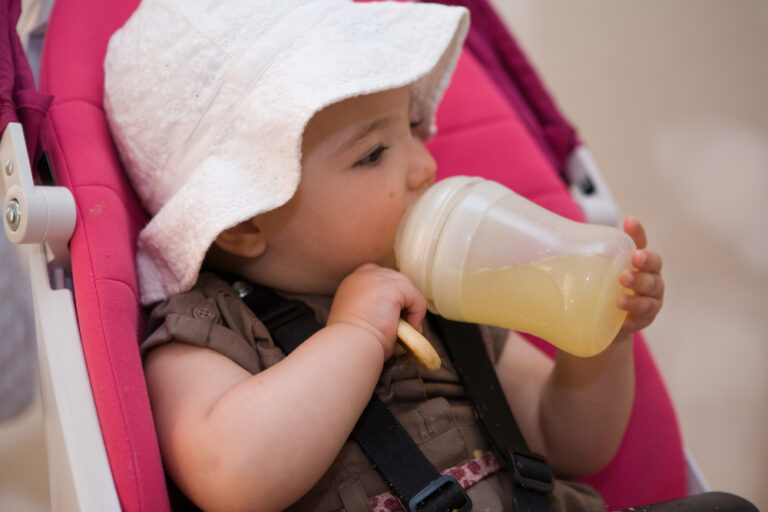As your baby grows you are likely wondering when the best time to introduce new food and drink is. From introducing new flavors to battling constipation, limited juice consumption does have its benefits, but when is it appropriate to begin offering it to your baby?
General Rule
As a general rule of thumb, breast milk and formula are the only things your baby needs to drink prior to 6 months of age. By 6 months offering water is a great alternative, especially alongside meals as you introduce more and more solid foods.
In 2017, the AAP changed their recommendations to waiting until children are over a year of age to introduce juice. The concern with juice has more to do with the sugar content, particularly because it can easily be overconsumed. Even 100% juice has a high level of sugar that is not a necessary addition to a baby’s diet.
Most pediatricians follow AAP guidelines and recommend waiting until 1 year of age to regularly introduce juice to babies. However, some will recommend introducing small amounts after 6 months of age. It is best to consult your family pediatrician if you have questions on what timing is best.
Choosing a Juice
Similar to introducing new foods, you should only introduce one new juice to your baby at a time. We recommend checking labels and looking for juices that have a small list of ingredients. 100% juice with no added sugar is the best option for young babies.
Pear, apple, and prune juice are all great options that can also help with mild constipation. They offer mild flavors that will not be overwhelming to young tastebuds. Once your baby is accustomed to new flavors you can introduce other options like orange, pomegranate, or cranberry juice. Dilute with water to prevent overwhelming your child. If you start with diluting juice, your child is more likely to tolerate light juice for longer, eliminating the concern surrounding heightened levels of sugar.
Amount of Juice
Most guidelines recommend no more than 4-6 ounces of juice a day for children starting at 12 months of age. As an example, a standard-sized juice box is typically 6 oz, which is at the top of the recommended daily intake amount. We don’t recommend offering juice every day, which makes it a special treat and something novel.
If you have a child who will balk at being offered a half-empty cup, we recommend that you dilute the juice with water. This way you can still offer your baby new flavors and something interesting to drink without increasing their sugar content drastically. Mix up the different juices you offer to give them a variety of new things to try.
Best Way to Offer Juice
Rather than offering juice in a bottle, it’s best to choose the right cup. There are all kinds of options based on children’s age, style, and material. If you’re looking for options, we have a great article on the best sippy cups for transitioning from a bottle to a cup.
Another great option is to introduce juice to your child in an open cup. The advantage to bottles and sippy cups is the low risk for mess and spills, however, the downside is that sugar and acid will sit on your baby’s teeth for longer than if an open cup is used. In addition to preventing tooth decay, practicing with an open cup will help your baby develop new drinking skills. Offering a variety of cup styles is particularly important if they are transitioning away from a bottle.
We also recommend offering juice during meal times. This is great practice for a number of reasons. One reason is that children will be consuming healthy and nutritious food at the same time, which will prevent them from filling up on juice. A second reason is that by eating at the same time, the sugar and acid from the juice will have less of an opportunity to just sit on your baby’s teeth.
FAQs – When to Give Juice to Babies
Do I need to buy juice specifically for babies?
Definitely not. There are brands that you can find in the baby aisle at your local supermarket or convenience store, but this is not necessary. Read the labels on juices and look for options that have few ingredients, and no added sugar. Here’s a quick comparison: Gerber Apple Juice, located in the baby aisle and geared specifically for toddlers, contains Apple Juice from Concentrate and Vitamin C (Ascorbic Acid). Great Value 100% Apple Juice, located in the grocery aisle, contains Apple Juice from Concentrate and Ascorbic Acid (Vitamin C). The exact same ingredients, however, the one geared towards toddlers costs 2x as much.
Are there any negative side effects of juice consumption?
Some of the most common side effects you may notice are looser stool or diarrhea, decreased appetite due to getting full from juice, or diaper rashes due to the acidity in juice. If you notice any of these side effects it may be an indication to decrease the amount of juice consumption until they clear up. As always, consult with your pediatrician if you have any concerns.
What are other ways to incorporate juice into my baby’s diet?
Juice can be a great way to offer flavor to a baby’s meal or snack. Consider blending a few ounces of juice into a smoothie that is packed with veggies, yogurt, and whole fruits. You can also blend together and freeze in a popsicle mold for a sweet treat on a hot day. While juice is not a necessary part of a baby’s diet, it is a great way to offer subtle flavors and something new and exciting.
Wrap Up
Juice is not a necessary part of a baby’s diet, but there are reasons why you might want to incorporate it. By following the AAP guidelines you can offer 100% juices in moderation as a way to introduce new flavors and variety to your child’s feeding routine starting at 12 months of age.
You want to see your child up for success when it comes to health and diet. By preventing early overconsumption of juice, you can avoid early sugar addiction which can lead to obesity. Instead, spend that first year introducing healthy, nutritious, whole foods and fruits to your baby. The first year is also a great time to get into a consistent oral hygiene habit with your baby before introducing sugars and acids that come pack in juices.
Once you feel that your baby is consistently getting good nutrients from food and is ready for juice, your options are endless! Juice boxes are convenient for popping into a diaper bag for an outing, can easily be frozen into popsicles, and can help ease the irritation of mild constipation. Have fun exploring new flavors with your little one.






